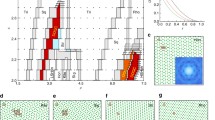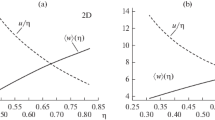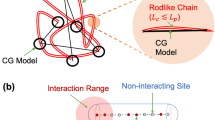Abstract
Some properties of a system of hard-core particles with attractive wells in the Baxter sticky-sphere limit and a related limit are considered, as is the approach to these limits. A demonstration of the result of Stell and Williams that sticky spheres of equal diameter in the Baxter limit are not thermodynamically stable is given, and the way in which size polydispersity can be expected to restore thermodynamic stability is discussed. The implications of these results for the PY sticky-sphere approximation and recent sticky-sphere computer simulations are then examined. It is concluded that the Baxter PY sticky-sphere approximation for a monodisperse system may well be a reasonable one for a slightly polydisperse system of sticky spheres and that existing simulation results may also be relevant to such a system. How polydisperse a system must be in quantitative terms in order for the PY approximation to be useful remains to be seen, however. The question of whether the PY sticky-sphere approximation may prove to be useful and appropriate in describing monodisperse systems with pair potentials for which the attractive wells arenot extremely narrow is also considered; it is noted that firm evidence concerning this question also appears to be lacking. Implications for systems near, but not in, the limit of zero attractive-well width are also considered, especially in terms of the relative size of the well width and the degree of size polydispersity in the repulsive cores. The possible pertinence of such considerations to colloidal systems is observed. The importance of taking into consideration the extremely long equilibration times that can be expected for systems with very narrow attractive wells is also pointed out, in connection both with real colloidal systems and in computer simulations. It is further observed that in the Baxter limit sticky spheres described quantum mechanically are indistinguishable from hard spheres so described; near the zero-well-width limit, the quantal behavior hinges on the number of bound states and thus the well depth as well as the relative size of the de Broglie thermal wavelength and the well width. Related results and investigations relevant to the issues described above are cited.
Similar content being viewed by others
References
R. J. Baxter,J. Chem. Phys. 49:2270 (1968).
B. Barboy and R. Tenne,Chem. Phys. 38:369 (1979).
S. Fishman and M. E. Fisher,Physica 108A:1 (1981); Y. C. Chiew and E. D. Glandt,J. Phys. A: Math. Gen. 16:2599 (1983).
P. T. Cummings and P. A. Monson,J. Chem. Phys. 82:4203 (1985); S. J. Smithline and A. T. J. Haymet,J. Chem. Phys. 83:4103 (1985); A. J. Post and E. D. Glandt,J. Colloid Interface Sci. 108:31 (1985),J. Chem. Phys. 84:4585 (1986); N. A. Seaton and E. D. Glandt,J. Chem. Phys. 86:4668 (1987),Phys. Chem. Hydrodynam. 9:369 (1987); Y. C. Chiew and E. D. Glandt,J. Phys. A: Math. Gen. 22:3969 (1989); C. G. de Kruif, P. W. Rouw, W. J. Bruis, M. H. G. Duits, A. Vrij, and R. P. May,Langmuir 5:422 (1989); S. V. G. Menon, V. K. Kelkar, and C. Manokar,Phys. Rev. A 43:1130 (1991).
G. Stell, inThe Equilibrium Theory of Classical Fluids, H. L. Frisch and J. L. Lebowitz, eds. (Benjamin, New York, 1964).
K. Hiroike,Mol. Phys. 34:1493 (1977).
F. H. Ree and W. G. Hoover,J. Chem. Phys. 41:1635 (1964).
F. H. Ree, N. Keeler, and S. L. Mc Carthy,J. Chem. Phys. 44:3409 (1966).
M. S. Wertheim,J. Stat. Phys. 35:19 (1984).
N. A. Seaton and E. D. Glandt,J. Chem. Phys. 84:4595 (1986);87:1785 (1987); W. G. T. Kranendonk and D. Frenkel,Mol. Phys. 64:403 (1988).
B. Barboy,J. Chem. Phys. 61:3194 (1974). See also J. N. Herrera and L. Blum,J. Chem. Phys. 94:6190 (1991) and references therein.
M. H. G. M. Penders and A. Vrij,J. Chem. Phys. 93:3770 (1990).
C. Regnaut and J. C. Ravey,J. Chem. Phys. 91:1212 (1989);92:3250 (1990).
J. C. Rasaiah and S. H. Lee,J. Chem. Phys. 83:6396 (1985),88:2093 (1988); J. C. Rasaiah, J. Zhu, and S. H. Lee,J. Chem. Phys. 91:495 (1989); J. Zho and J. C. Rasaiah,J. Chem. Phys. 91:505 (1989).
P. C. Cummings and G. Stell,Mol. Phys. 51:253 (1984);55:33 (1985).
G. Stell and Y. Zhou,J. Chem. Phys. 91:3618 (1989).
G. Stell, SUSB College of Engineering and Applied Sciences Report No. 461 (1985).
M. S. Wertheim,J. Chem. Phys. 85:2929 (1986).
L. Boltzmann,Vorlesungen über Gastheorie II (J. A. Barth, Leipzig, 1898) [Lectures on Gas Theory, S. G. Brush, transi. (University of California Press, 1964).
P. C. Cummings and L. Blum,J. Chem. Phys. 84:1833 (1986); L. Blum, P. T. Cummings, and D. Bratko,J. Chem. Phys. 92:3741 (1990).
P. C. Hemmer and G. Stell,J. Chem. Phys. 93:8220 (1990).
B. Tooker and G. Stell, SUSB College of Engineering and Applied Sciences Report No. 521 (1988).
M. Penrose, O. Penrose, G. Stell, and R. Pemantle, Quantum mechanical sticky spheres, preprint.
Author information
Authors and Affiliations
Rights and permissions
About this article
Cite this article
Stell, G. Sticky spheres and related systems. J Stat Phys 63, 1203–1221 (1991). https://doi.org/10.1007/BF01030007
Received:
Issue Date:
DOI: https://doi.org/10.1007/BF01030007




